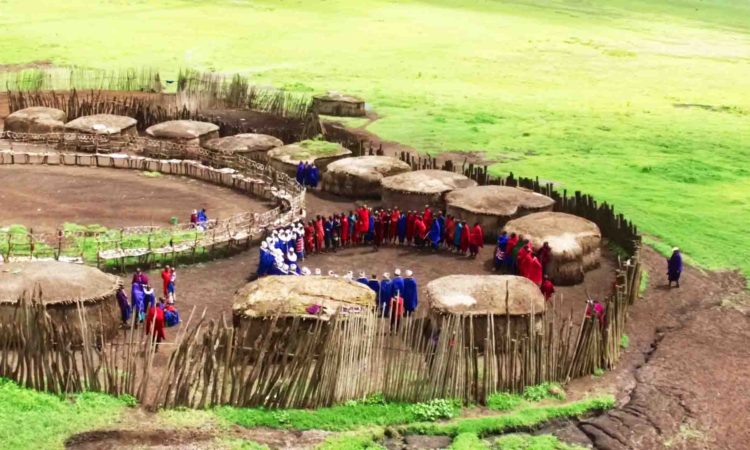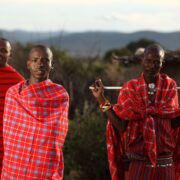
Discovering Tanzania’s Rich Cultural Heritage (2025 Guide)
The Soul of Tanzania: An Introduction
As dawn breaks over the Maasai Steppe, the rhythmic chanting of red-robed warriors pierces the morning silence. This is Tanzania beyond the postcard perfection of wildlife safaris – a land where ancient traditions breathe life into every sunrise, and centuries-old customs paint each sunset with stories of human perseverance and cultural pride.
The Maasai: Warriors of Tradition
Life in a Traditional Maasai Boma


Step through the thorny acacia branches that form the protective outer ring of a traditional Maasai boma, and enter a world unchanged by centuries. The circular arrangement of mud-and-dung houses, each meticulously crafted by Maasai women, creates a central courtyard where life unfolds in its daily rhythm.
The Architecture of Tradition
The traditional Maasai house (Inkajijik) tells a story of ingenuity and adaptation. Built by women using a framework of timber poles planted in the ground, the structure is interwoven with a complex lattice of smaller branches. This framework is then covered with a careful mixture of mud, cow dung, grass, and ash – creating a waterproof barrier that remains cool in the intense heat and warm during cold nights. The small entrance forces one to bow while entering, a sign of respect for the home’s sanctuary.
Daily Life and Rituals
Inside the boma, life moves to an ancient rhythm. Before sunrise, young warriors (Morani) lead cattle to grazing grounds, their deep voices carrying traditional herding songs across the savannah. Women, adorned in vibrant beaded necklaces that tell stories of their status and beauty, begin their daily tasks:
- Collecting water from distant sources, balanced expertly in gourds
- Milking cows in carved wooden containers passed down through generations
- Crafting intricate beadwork, each color and pattern holding deep cultural significance
- Preparing traditional medicines from carefully gathered plants and roots
The Dance of the Warriors
As evening approaches, witness the famous Adumu (jumping dance). Young warriors form a circle, their beaded ornaments catching the golden light. The deep, rhythmic chanting begins low, like distant thunder, before rising in intensity. One by one, warriors enter the circle, launching themselves skyward in gravity-defying leaps. The dance is more than entertainment – it’s a demonstration of strength, grace, and warrior pride.
Coastal Swahili Culture: Where Africa Meets the Indian Ocean
Stone Town’s Living History
In Zanzibar’s Stone Town, narrow streets wind like ancient rivers between coral stone buildings. The heavy carved doors, each unique, tell stories of wealth, status, and cultural influence:
The Language of Doors
- Indian-style doors: Brass studs arranged in diamond patterns
- Arab-style doors: Intricate geometric carvings
- Chinese-influenced doors: Ceramic inlays and gold leaf details
The air is heavy with the scent of:
- Cloves drying on woven mats
- Cardamom and cinnamon from spice markets
- Fresh bread from street vendors
- Incense wafting from hidden courtyards
Traditional Swahili Craftsmanship
The Art of Dhow Building
On the beaches north of Stone Town, master craftsmen continue centuries-old traditions of dhow building. Without written plans, these artisans:
- Shape massive timber planks using hand tools passed down generations
- Join planks using coconut fiber rope and wooden pegs
- Create vessels that navigate by stars and seasonal winds
- Apply traditional coconut oil treatments to protect the wood
The Hadzabe: Keepers of Ancient Knowledge
A Day with the Last Hunter-Gatherers
Deep in the Lake Eyasi region, the Hadzabe people maintain one of humanity’s oldest lifestyles. Their day begins before dawn:


Morning Hunt
- The soft whisper of bow strings being checked
- Complex bird calls used for communication
- Traditional tracking techniques reading the smallest signs
- Knowledge of over 200 bird species and their behaviors
- Understanding of animal movement patterns passed down orally
Gathering Traditions
The women’s gathering expeditions reveal encyclopedic knowledge of:
- Over 150 edible plant species
- Dozens of medicinal roots and herbs
- Seasonal fruiting patterns
- Traditional food preservation techniques
- Ancient cooking methods using heated stones
The Makonde: Masters of Ancient Artistry
Wood Carving Traditions
In the southern regions, Makonde masters transform African Blackwood into intricate sculptures:
The Creation Process
- Selection of wood based on spiritual connection
- Traditional tools handed down through generations
- Carving techniques that ‘release’ spirits from the wood
- Complex family stories told through interconnected figures
- Ancient finishing methods using natural oils and pigments
Cultural Expressions
Traditional Music Heritage
Instrumental Traditions
- Marimba: Complex wooden xylophones producing haunting melodies
- Zeze: Two-stringed instruments creating soul-stirring sounds
- Ngoma drums: Various sizes for different ceremonial purposes
- Kudu horns: Used for long-distance communication
- Kayamba shakers: Made from reed and filled with seeds
Vocal Traditions
- Call-and-response patterns
- Complex harmonies passed down orally
- Storytelling through song
- Ceremonial chants
- Work songs for different activities
Traditional Healing Arts
The Medicine Men
Local healers possess knowledge of:
- Hundreds of medicinal plants
- Traditional diagnostic techniques
- Spiritual healing ceremonies
- Seasonal gathering patterns
- Ancient preparation methods
Recent Posts
The Perfect Time for a Safari in Tanzania
Best travel advice to travel in Tanzania in 2025
Discovering Tanzania’s Rich Cultural Heritage (2025 Guide)
All Categories





